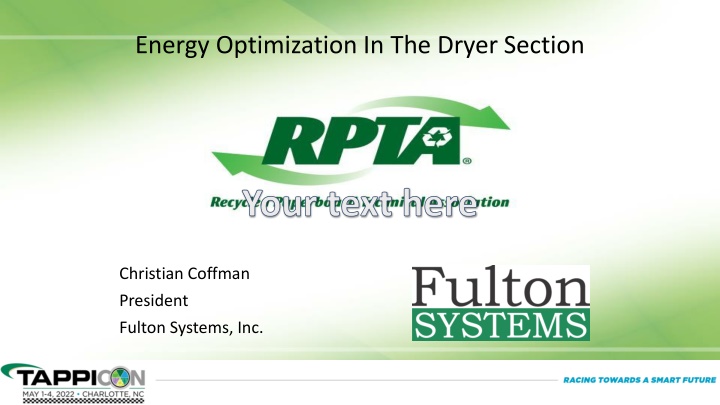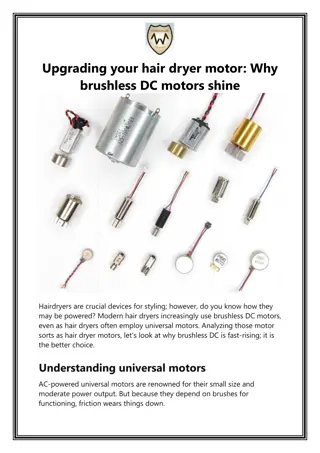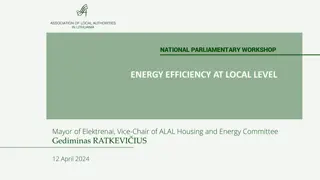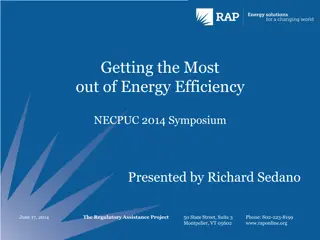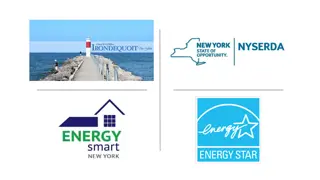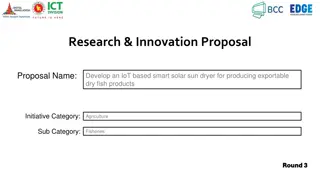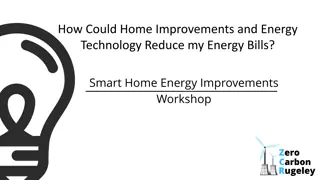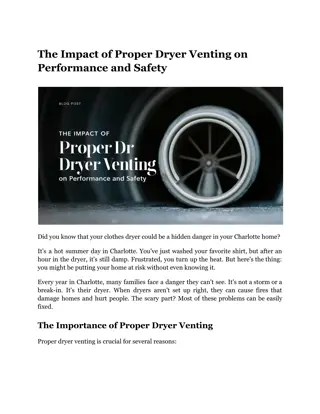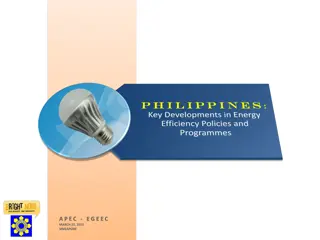Energy Optimization in Dryer Section: Improving Efficiency and Performance
Explore the impact of steam and condensate systems on energy usage in the dryer section, including strategies for optimizing energy consumption and improving drying rates. Learn about the effects of steam temperature, drying segmentation, and ways to enhance system efficiency for better overall performance.
Download Presentation

Please find below an Image/Link to download the presentation.
The content on the website is provided AS IS for your information and personal use only. It may not be sold, licensed, or shared on other websites without obtaining consent from the author.If you encounter any issues during the download, it is possible that the publisher has removed the file from their server.
You are allowed to download the files provided on this website for personal or commercial use, subject to the condition that they are used lawfully. All files are the property of their respective owners.
The content on the website is provided AS IS for your information and personal use only. It may not be sold, licensed, or shared on other websites without obtaining consent from the author.
E N D
Presentation Transcript
Energy Optimization In The Dryer Section Your text here Christian Coffman President Fulton Systems, Inc. Information Classification: General
Effects of Steam & Condensate Systems on Energy Mill & Machine Energy Usage Steam & Condensate Effectiveness Steam & Condensate Overview Specifics to Investigate Summary Information Classification: General
ENERGY CONSUMPTION (000 BTUs / Ton) 3500 3000 Electricity 2500 Steam 2000 1500 1000 500 0 Stock Prep Forming, Pressing Drying (Finishing) Other Information Classification: General
STEAM & CONDENSATE STEAM & CONDENSATE SYSTEMS EFFICIENCY SYSTEMS EFFICIENCY Drying Rate Lbs. H2O Evap. per Ft2 of Drying Surface Compare to Other Machines Similar Grades Similar Conditions Lbs. Steam used per 1 Lb. H2O Evap. 1.1 Best 1.2-1.3 Efficient 1.4+ Excessive Information Classification: General
Linerboard Drying Rate Tappi TIP-0404-07 Fig. 3E (Revised 2017) 8.0 7.5 MAX 7.0 6.5 6.0 5.5 Drying Rate (lb H2O/hr-sf-'F) 5.0 MIN 4.5 4.0 3.5 3.0 2.5 2.0 1.5 1.0 0.5 0.0 280 290 300 310 320 330 340 350 360 370 380 Steam Temperature deg F Information Classification: General
DRYING SEGMENTATION SHEET WARMING CONSTANT DRYING STAGE FALLING RATE Lead dryers, 10- 15% raw stock dryers Dryers Main dryers Last 10-25% dryers Raise sheet consistency to 80+% Raise sheet consistency to 95+% Heat supplied = latent heat of evaporation + heat to break water/fiber bonds Quickly raise sheet temp to 185+ oF Function Max without causing quality problems Heat supplied = latent heat of evaporation Heat Transfer Condensate High Average Low Information Classification: General
DRYING SEGMENTATION WARM-UP ZONE Raise press exit sheet temperature to 185+ oF as quickly as possible Rate of temperature increase = Sheet Tolerance Heats water; little evaporation 10-15% of dryers Normally most important, most neglected section Common problems Picking Curl (after size press) Information Classification: General
DRYING SEGMENTATION CONSTANT DRYING RATE ZONE Maintain sheet temperature Maximum capacity = Dryer MAWP rating Sections In general, the greater the number The more the Flexibility The better the efficiency Steaming sections = drive sections Control Cascade, Recirculating Pressure Control Blow through Flow Control Differential Pressure Control Best place to measure, control sheet reel moisture Information Classification: General
DRYING SEGMENTATION Falling Rate Zone Often overlooked Over drying = energy loss Typically highest operating steam section Worst place to target final sheet moisture Information Classification: General
TEMPERATURE PROFILE 330 70 psiG 320 55 psiG 310 300 290 280 270 260 15 psiG TEMPERATURE, Deg F 250 240 230 220 210 200 190 180 Dryer Valved 170 160 Off 150 140 130 120 MECHANICAL GROUP 46-55 MECHANICAL GROUP 32-45 MECHANICAL GROUP 16-31 MECHANICAL GROUP 1-15 110 0 1 2 3 4 5 6 7 8 9 10 11 12 13 14 15 16 17 18 19 20 21 22 23 24 25 26 27 28 29 30 31 32 33 34 35 36 37 38 39 40 41 42 43 44 45 46 47 48 49 50 51 52 53 54 55 56 DRYER NUMBER Steam Sheet Information Classification: General
Steam-to-Dryer Surface Temperature Difference 120 6th Steaming Section Dryers 74-79 5th Steaming Section Dryers 60-73 4th Steaming Section Dryers 40-59 1st Steaming Section Dryers 1-7 "3rd Steaming Section Dryers 24-39 2nd Steaming Section Dryers 8-23 110 100 90 TEMPERATURE DIFFERENCE, Deg F 80 70 TEFLON COATED 40~43 60 50 40 30 BREAKER STACK 20 10 0 0 1 2 3 4 5 6 7 8 9 39.5 10 11 12 13 14 15 16 17 18 19 20 21 22 23 24 25 26 27 28 29 30 31 32 33 34 35 36 37 38 39 40 41 42 43 44 45 46 47 48 49 50 51 52 53 54 55 56 57 58 59 60 61 62 63 64 65 66 67 68 69 70 71 72 73 74 75 76 77 78 79 80 DRYER NUMBER Information Classification: General
DRYING SEGMENTATION Drying Rate Zones 50- 60% Sheet Moisture Content, % Sheet Temperature, oF 200+ 180- 190 Falling Rate Zone 90- 110 Constant Rate Zone Warm-up Zone 5% 1 Last Dryer Number Information Classification: General
HEAT TRANSFER Removal Evaporated Water & Air Sheet Shell Syphon & Joint Steam (Blowthrough) Salvage Information Classification: General
Dryer Heat Transfer R = All Resistances (Ft2/HR/ F) BTU THERMAL RESISTANCES Air (Non-Condensable) Heavier Than Steam Each 1% Air = 4+% Less Heat Transfer Condensate Usually Most Significant Factor 10xs More Than Cast Iron Scale Biggest Problem in Non-uniform Drying. Sheet -To-Shell Contact Reduce Insulating Air R Information Classification: General
Syphons - The Beginning of Steam System Design Syphon selection, or existing, drive steam and condensate system design Dryer drainage challenges often relate to syphon issues Syphon and the steam system do not match Excessive blow through steam / Excessive differential pressure requirements. Syphon differential pressure versus steam section differential pressures. Information Classification: General
STATIONARY SYPHON CURVE 10 9 8 RECOMMENDED RANGE DIFFERENTIAL PRESSURE, psid 7 Section Differential Pressure - 6.0 psiD 6 Piping Losses = 2.5 psiD Operating 6.0 psiD header to header equals ~3.5 psiD at the syphon 5 4 Header to Header psiD 3 2 1 0 0% 2% 4% 6% 8% 10% 12% 14% 16% 18% 20% 22% 24% 26% BLOWTHROUGH STEAM FLOW Syphon Clearance - 1.0" Syphon Hdr to Hdr Information Classification: General
DRYER BARS Turbulent Action Produced by Dryer Bars DRYING INCREASE, % 40 30 20 10 1000 2000 3000 SPEED, fpm Information Classification: General
DRYER SYSTEM ARCHITECTURE Interdependent Sections (Cascade) Main Steam Header Make-up Valve Make-up Valve Steam Supply Header DRYER SECTION Low Press. DRYER SECTION High Press. Condensate Header Vent Valve Vent Valve Separator Separator Condensate Return Condensate Return Information Classification: General
DRYER SYSTEM ARCHITECTURE Independent Sections (Recirculating) Motive Steam Header Main Steam Header Make-up Valve Thermocompressor Steam Supply Header ANY DRYER SECTION Condensate Header Vent Valve Separator Condensate Return Information Classification: General
DRYER SYSTEM ARCHITECTURE Main Steam Header PV PIC Condensers Steam Supply Header PT DRYER SECTION Vent, Low Pressure Use Condensate Header Steam Separator TIC TV Cooling Water Condensate Return TT Vacuum Pump Vacuum Receiver Condensate Return Information Classification: General
DRYER SYSTEM ARCHITECTURE FACTOR CASCADE RECIRC. Flexibility Minus Plus Simplicity Plus Minus Capital Cost Plus Minus Energy Cost Minus/Plus Plus Capacity Minus Plus Grade Range Minus Plus Information Classification: General
DRYER SECTION TARGETS Performance (BTUs / # Water Evaporated USAGE BEST GOOD POOR Sheet Warm-up 85 120 160-200 Sheet Drying 990 990 990 Air Warm-up 180 200 350-500 Vents, Bleeds, Leaks 20 25 100 Radiation 0 40 60 Condenser 0 100 500 Total 1275 1475 2160-2350 PV Supply Temp F 180 180-200 210+ # Steam/# H2O Evaporated (approx) % Condensate Return 1.2 1.4 2.0+ > 85% 85% 70% or less Information Classification: General
Dryer Steam System Opportunities Reduce quantity of dryers in falling rate zone. Ensure cascade systems are balanced properly for maximizing production and managing blow through steam flows. Minimize quantity of dryers discharging to condensers. Eliminate steam venting during normal production, minimal during upset conditions Evaluate syphon geometries (size), types and modify to reduce excessive blow through flow rates. Optimize thermocompressor sizing to match properly sized syphon geometries across production grade structures. Information Classification: General
Dryer Steam System Opportunities Improve heat transfer rate Dryer Bars where applicable Minimal condensate layer Remove scale / buildup from dryer surface Control Strategies Differential Pressure / Blow Through Flow Control Verify mechanical valve integrity of steam section atmospheric vent valves. Utilize available condensate energy from dryer section in collection module flash tank. Maintain instrumentation Information Classification: General
